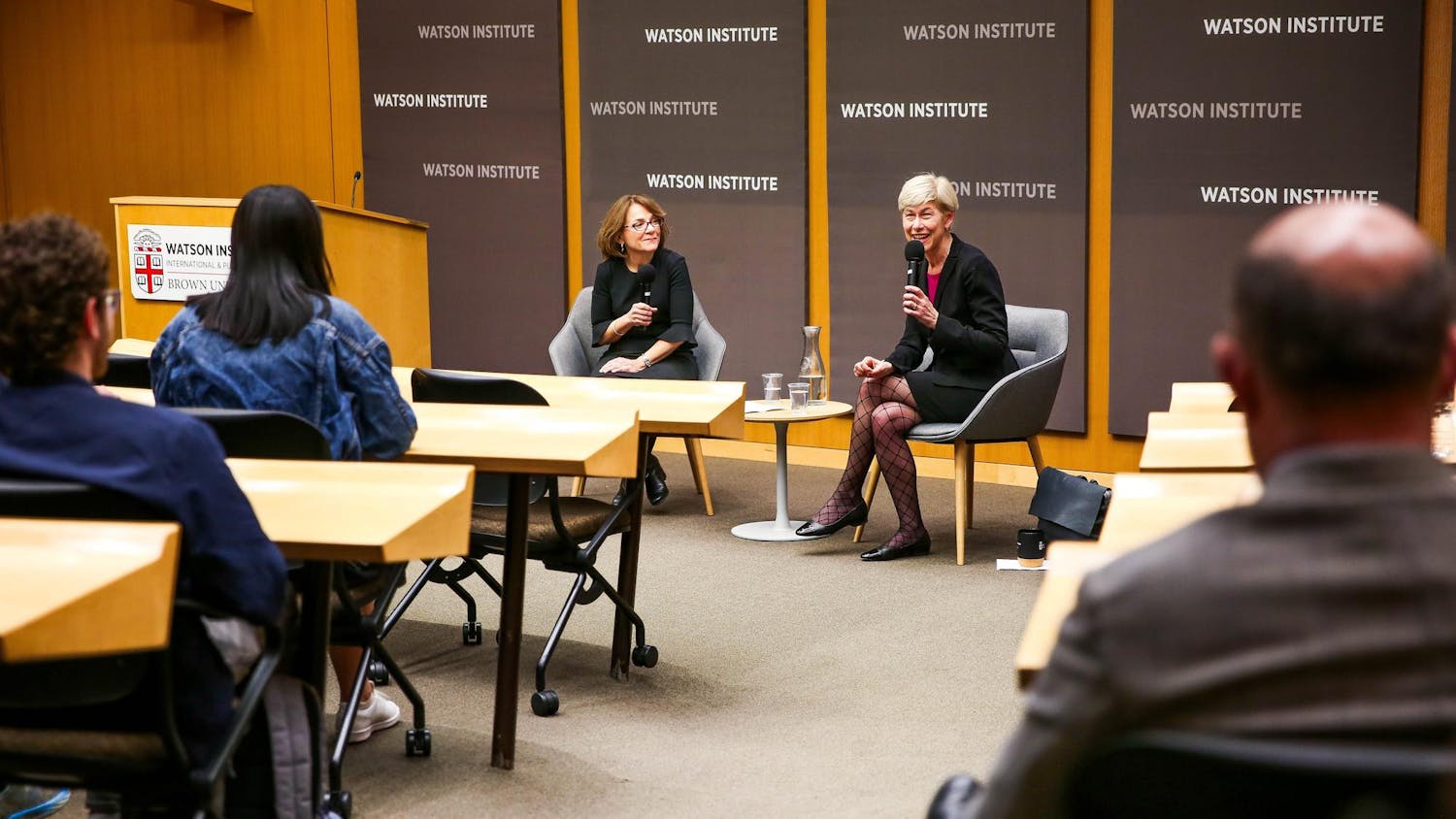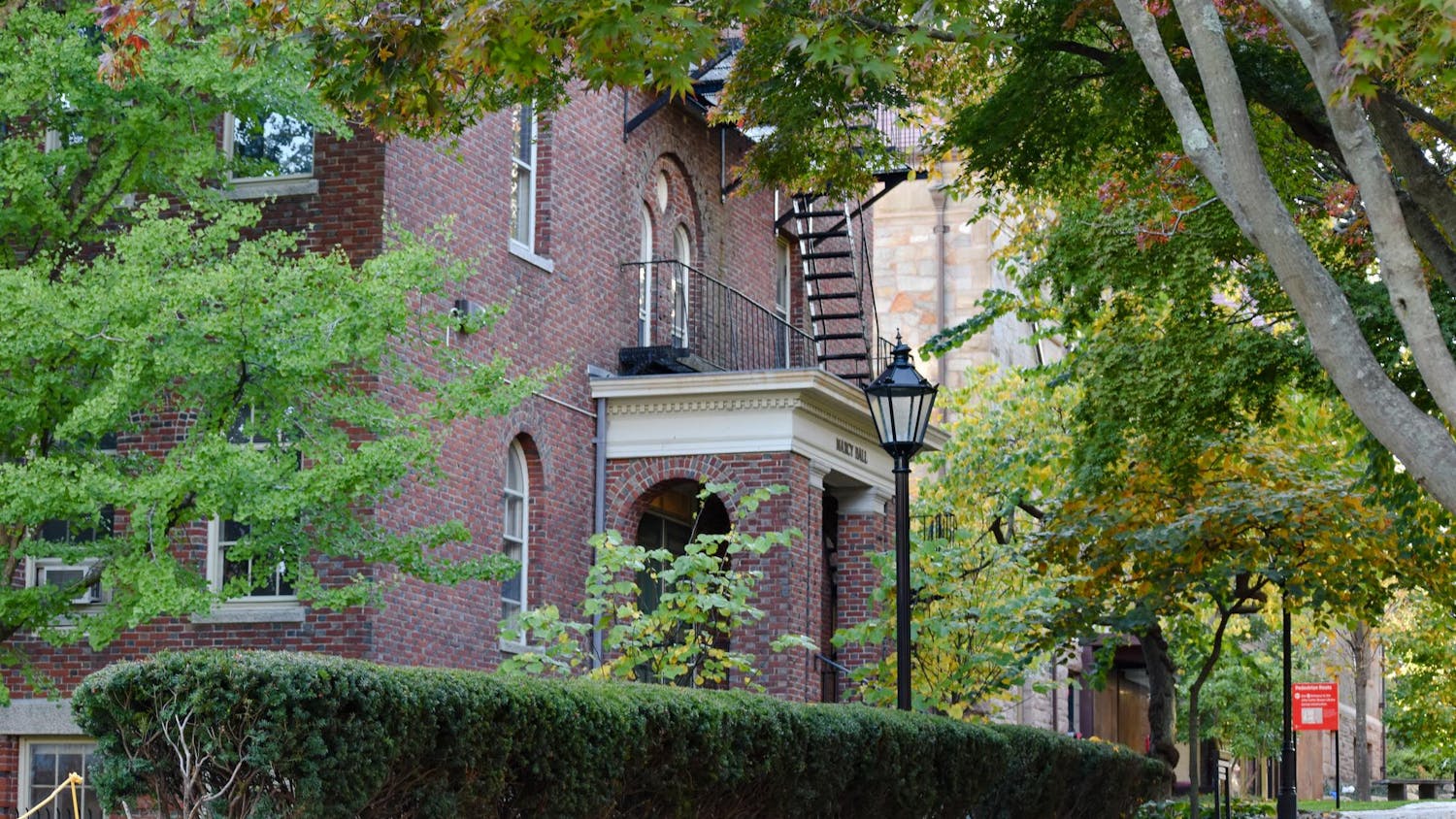“Kill Wilson” is the fourth, and last, final project for PHP 1680I: “Pathology to Power: Disability, Health and Community.” This article is the final installment in a series covering students’ attempts to increase the visibility of disability on campus.
Caroline Orr ’16 called out over the hubbub of voices in the Blue Room that a student-produced film on the accessibility of Wilson Hall, called “Kill Wilson,” would be screened in Peterutti Lounge at 7 p.m. Thursday. “There will also be pizza and a dog,” she added, her words immediately followed by a collective scraping of chairs.
Earlier this semester, students in the course PHP 1680I: “Pathology to Power: Disability, Health and Community,” challenged students without disabilities to enter Wilson Hall using a wheelchair or a pair of crutches. The film showed three students’ attempts to enter Wilson while simulating having mobility impairments — ironically to the sound of jazzy elevator music. While half the section worked on the film, the other half talked to University administrators about why Wilson is as inaccessible as it is today, said Libby Zorn ’16, a coordinator of the event.
Zorn said the project was born out of “sitting in section and griping about Wilson Hall, because someone had had trouble getting to class.” Students then began to recount similar stories about the building, she said.
Their shared experiences inspired them to create an anonymous survey asking students about any difficulties they may have had navigating Wilson Hall. Students then circulated the survey among friends, classmates and sports teams. “A lot of people who have mobility issues on Brown’s campus are student athletes who get injured,” Zorn said.
The number of responses made our section realize how big a problem Wilson’s inaccessibility is, Zorn said.
“Forty percent of the student population uses Wilson Hall,” Orr said. “Over 19 classes are conducted there.”
Zorn said Wilson is also used for club meetings, a cappella auditions, as well as class sections and problem set-solving sessions. Zorn added that emergency medical technicians cannot use stretchers within Wilson if students inside require medical attention.
Before the screening of the 10-minute film, Orr said the organizers’ objective was to encourage Brown students to be as vocal about ableism as they are about other issues on campus. “This is a great moment for student activism,” she said.
Not a quick fix
Vice President of Facilities Management Stephen Maiorisi said Facilities Management was aware of the accessibility concerns raised. “Wilson has been high on the list for a couple of years in terms of ‘we need to do something here,’” he said. As part of the capital planning process, campus buildings are ranked based on need. “Need” is based on the number of students who use the building and the building’s mechanical issues, he said.
“I imagine that something is going to be done with regard to Wilson as part of the next capital project,” Maiorisi said, referencing President Christina Paxson’s P’19 strategic plan, “Building on Distinction.” Capital projects are not linked to a definitive timeframe, though projects tend to be completed within an 8- to 10- year period once put on the agenda, Maiorisi said. “It’s hard to say for sure because of funding issues,” he added.
Unlike other inaccessible buildings, Wilson Hall’s accessibility problems cannot be solved by the installation of a lift or a ramp, Maoirisi said. The floors within Wilson Hall are at different levels and the building would require a complete renovation in order to be made fully accessible. “As it stands, once you get inside that building, even if we got you to the first floor, there’s nowhere you can go,” he said.
“The main barrier to progress is the cost of physical renovations,” wrote Sazzy Gourley ’16, president of the Undergraduate Council of Students, in an email to The Herald.
Maiorisi said while these factors pose significant challenges, renovation of Wilson Hall was not impossible. Smith-Buonanno Hall was renovated from scratch in 2000, he said, and it was made “completely accessible” as a result.
“Unequivocally, when we take on any renovation project, we make it accessible, as well,” Maiorisi said.
Maiorisi said renovation plans for the next year included installing elevators in both Manning Chapel and Andrews House, the home of Health Services. He estimated that both projects would be completed this summer.
Student and Employee Accessibility Services has worked with Health Services to make any necessary medical assistance available on the first floor in the meantime, said Catherine Axe ’87, SEAS director.
While walking through the Main Green during last week’s project “Grading the Green,” Maiorisi said he remembered thinking that the students’ letter grades were “probably exactly the same ones we would have given them as well.” The age of the buildings and Brown’s topography make addressing accessibility concerns particularly challenging, he added.
“We’ve made a tremendous amount of improvement over time in terms of accessibility, and we are going to continue to do so,” Maoirisi said, emphasizing that making the campus accessible is a work in progress.
Looking ahead
UCS is “advocating for the administration to create mechanisms to hold faculty accountable for complying with SEAS accommodations and Dean’s notes,” Gourley wrote.
“All the concerns that have been raised so far in these articles (regarding Pathology to Power) are actionable,” Axe said.
Maorisi said Facilities Management and the Office of the Provost are in the initial stages of developing a plan to render the President's office accessible.
“We have also requested that there be better signage in buildings,” Axe said, adding that SEAS would be working with Facilities Management to ensure that the International Symbol of Accessibility — the classic symbol of a person in a wheelchair — would be more visible in the future.
Axe also said SEAS is working on having disability feature more prominently in Paxson’s action plan for diversity and inclusion. “I am working on suggestions to ensure that we are not overlooked where diversity is concerned,” she said. These suggestions include plans to increase the number of courses on disability and to create a Department of Disability Studies in the long term.
SEAS also recently facilitated the launch of a student-run mentoring program — the Bob and Charlie Poole Mentoring Program — to foster a spirit of community among students with disabilities. “One of our goals is to function more like a center,” Axe said, envisioning a SEAS support system in the same vein as the Sarah Doyle Women’s Center or the LGBTQ Center.
The creation of such a center is difficult because of the lack of space available to SEAS at their current location, Axe said. Brown’s expansion into the Jewelry District involves the relocation of numerous offices across the river, which could free up space for SEAS’s expansion, she added. SEAS itself has no plans to move to the Jewelry District. “We would always want to remain very central. It’s important not to have too many steps to reach us,” Axe said.
Axe also encouraged students without disabilities to engage with SEAS to support their peers. The SEAS website lists email addresses and telephone numbers where students can report technical failures and maintenance issues, she said. “Students are also welcome to walk into the office and voice their concerns,” Axe added.
In a previous version of this article, it was stated that plans were being developed to make University Hall more accessible, but in fact, plans are being made to specifically make the President's office, which is within University Hall, more accessible. The Herald regrets the error.




